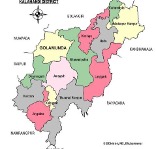
Kalahandi

Outreach by Numbers
Kalahandi district, located in the southwestern part of Odisha, is predominantly inhabited by tribal communities. The district comprises two sub-divisions, 13 blocks, and 2,253 villages, with a population of 1,576,869. Scheduled Castes and Scheduled Tribes make up 18.17% and 28.50% of the population respectively.The economy is primarily agrarian, with 92.26% of residents living in rural areas. Major crops include paddy, green gram, and maize, supplemented by livestock rearing and NTFP collection. Forest-based products like Mahua, Kendu-Leaf, Wood, Timber and Bamboos also contribute to the local economy.
Harsha Trust began addressing poverty, malnutrition, and irrigation and allied agricultural issues in the Kalahandi district by collaborating with organizations like NABARD, ICRISAT, Tata Trusts, Axis Bank Foundation, and Caring Friends and convergence with govt. line departments. Currently Harsha Trust’s interventions span two blocks; Thuamul Rampur and Golamunda engaging over 11,912 households across 220 villages, focusing on improving livelihoods, health, and nutrition security, as well as supporting climate-resilient agricultural practices.
Key highlights/progress in the year (2023-24)
- Lives of 392 ultra-poor households in Thuamul Rampur and Golamunda Block were transformed through productive asset creation such as nutrition gardens, goat sheds, poultry sheds, snacks centers, grocery shops, tailoring units, etc., supported by Axis Bank Foundation.
- 7 Livestock Entrepreneurs supported by Axis Bank Foundation provided livestock management facilities at the doorstep, benefiting 2000+ households in 75 villages.
- Arhar cultivation supported by ICRISAT has benefited around 2860 households in 92 Villages in 2 blocks, with additional income generation, soil nutrient management, and nutrition security.
- Promoted NPM Agriculture guided by N+3F, which reduced pesticide use and the cost of cultivation for 1,397 farming households by 70%, simultaneously enhancing soil health and protecting biodiversity in both blocks.
- Drumstick plantation in Wadi models is promoted for 220 households over an area of 18.5 acres in Golamunda block supported by Axis Bank Foundation and community contribution to diversify nutrition and livelihood options.
- The health and nutrition awareness program supported by Axis Bank Foundation and Caring Friends in convergence with ICDS and Health Department has enabled better RMNCAH+ services for 4,895 children less than 5 years, 2,438 adolescent girls, 2,596 pregnant and lactating mothers in the district.
- Establishment of 5,000 + Nutrition Gardens supported by Axis Bank Foundation, Caring Friends, and Horticulture Dept. has helped in addressing gaps in food and nutrition security.
- Successfully installed solar bore-wells worth Rs. 2.5 Crore in Thuamul Rampur block in convergence with OLIC, benefitting more than 100 farmers. Created 3 solar river-lift irrigation units in Golamunda block, supported by Axis Bank Foundation, which enhanced crop production over 25 acre area, supporting 37 farmers.